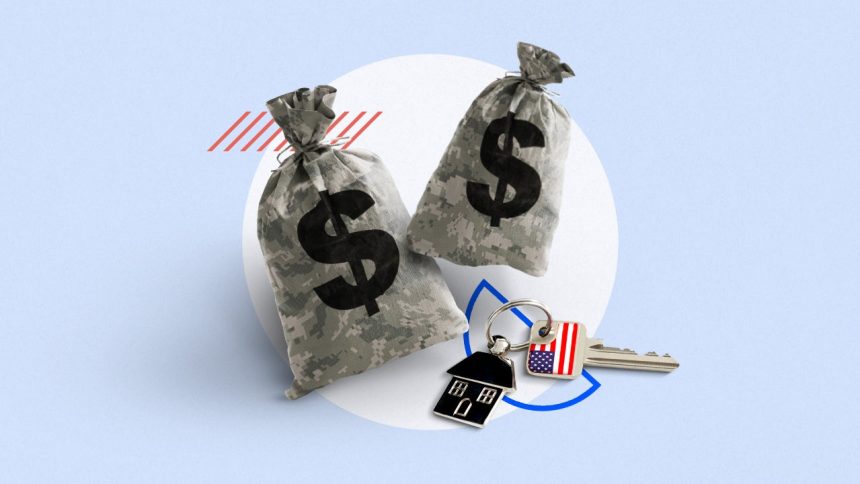Key takeaways
- You can have multiple VA loans throughout your life, but only in certain situations, such as selling your current home and buying a new one or refinancing your existing VA loan.
- VA loan entitlement is the amount of money the VA will guarantee for a home loan, and it can be restored if you sell your home and pay off the loan.
- You can rent out your existing VA loan property and purchase another home with a VA loan, but there are limitations, and the rental income cannot be used to offset your debt-to-income ratio.
You already bought a home using a VA loan. Now, you might be asking yourself: “Can I get a second VA home loan?” The answer is yes, but before you apply, it’s important to learn how your entitlement benefit works, what you’ll pay for a funding fee and various other considerations.
How many VA loans can you have?
VA loans are designed to help eligible borrowers purchase or refinance a primary residence. But in some cases, you can buy a home using a VA loan, then refinance or buy another home with a separate VA loan.
So, can you get a second VA home loan? Yes, but only in certain situations. Here are a few scenarios which may require an additional VA loan:
Selling your current home and buying a new one
If you’ve already purchased a home with a VA loan, then sell that property, you restore your entitlement and can buy your next home with a new VA loan. In this scenario, you can ultimately have as many VA loans as you want throughout your life, provided you sell each home and move.
Refinancing your VA loan to another
Refinancing your VA loan terminates your current loan and begins a new one. With a VA cash-out refinance you can liquidate the equity you have in your home for cash. If you’re simply looking for a better interest rate, you can apply for a VA IRRRL, also known as a streamline refinance.
Using VA loans for two different homes
Getting a second VA loan on a different home is possible. It often happens when an active service member receives Permanent Change of Station orders. However, a VA-approved lender must approve you having multiple loans. Essentially, you’ll need to show that you have the means to repay both loans at once. You’ll also need to confirm you have enough VA entitlement remaining to purchase the home you want.
What is VA loan entitlement?
VA loan entitlement is the amount of money the Department of Veterans Affairs (VA) will guarantee on a home loan. This helps determine how much you can borrow before needing a down payment. Entitlement protection encourages lenders to offer VA loans with lower rates, no down payment and easier qualifying guidelines.
Depending on your history with VA loans, you may have full or partial entitlement. Let’s look at the difference between the two, specifically how entitlement applies when you’re trying to get a second VA home loan.
- Full entitlement. You have full entitlement if you’ve never previously purchased a home using a VA loan, paid off a prior home with a VA loan and sold that property, or had a home with a VA loan foreclosed or short-sold but fully repaid the loan. With full entitlement, you don’t need to make a down payment.
- Partial or reduced entitlement. If you have an active VA loan and you’re applying for a second, you have partial entitlement. Your remaining entitlement depends on the percentage of the allowed entitlement you’ve already used with an active loan.
Restoring your VA mortgage entitlement
Remember: You have an entitlement limit, but you can restore your entitlement by selling your home and paying off the VA loan in full. If your loan is merely paid off or refinanced and you still own the house, the entitlement amount remains tied up in the home.
Fortunately, there’s an exception: You can request a one-time restoration of entitlement benefit, even if you’ve not met the VA’s must-sell rule. Say the buyer of your home for sale is a veteran who takes over your existing VA mortgage (called an “assumption”).
“You can ask this person to substitute his or her entitlement for the same amount of entitlement you originally used. If they agree, your original entitlement will be restored,” says Yvette Clermont, a mortgage consultant with Waukesha, Wisconsin-based Novus Home Mortgage.
If the buyer disagrees, the entitlement you used to buy the home will remain tied up in the property until the new owner fully repays the loan.
Forfeiting your VA loan entitlement
If you default on your VA loan, you can permanently lose your entitlement. In that case, the lender forecloses on and sells your home for less than you owe, and the VA has to reimburse the lender. The VA’s payment to the lender is deducted from your entitlement, and you can’t get it back.
This is also true of a short sale, where the lender sells your home at a loss. Unfortunately, you can’t use your one-time restoration of entitlement benefit for a short sale or foreclosure.
How to get a second VA loan
Getting a second VA home loan will likely resemble how you got your first VA loan. Here’s a rundown of the key steps involved:
- Request your certificate of eligibility (COE). This document proves to lenders you’re qualified to receive a VA loan and also helps you understand how much of your entitlement benefit is available for use. You can get it online through your VA benefits portal or by reaching out to your regional service center. You might also need your discharge papers.
- Determine if you want to restore your full entitlement. If you plan to buy a new home, you might want to consider selling your current home to get your full entitlement benefit.
- If it’s a refinance, determine if more money or less work is more important: If you’re simply considering refinancing your mortgage, think about which loan is better for you: a cash-out refinance, or a VA interest rate reduction refinance loan (IRRRL).
- Get your finances in order. While the VA doesn’t require a minimum credit score, VA lenders typically do. Review your credit report, pay off credit cards and take other steps to show you’re able to pay your new monthly mortgage payments.
Second VA loan funding fees
The funding fee is an inescapable expense for most VA loan borrowers. On a second loan, you could wind up paying more for it. If you make a down payment of less than 5 percent of the purchase price the second time you take out a VA loan (and any other time after), the funding fee is 3.3 percent. If you can make a down payment of more than 5 percent or 10 percent, the funding fee comes down to 1.5 percent or 1.25 percent, respectively.
Buying vs. renting using entitlement
What about renting your home while trying to buy another one with a VA loan?
“This might occur if, for example, you are stationed at a different location but don’t want to sell your existing home. In this case, you decide to rent out your existing property and buy another one,” says David Reischer, an attorney in New York City.
There’s a catch: You can’t convert your primary residence into a rental and buy a similar-sized home in the same location. The second home would have to be a larger residence or be in a different area.
“You would not be able to use any of that rental income to reduce your debt-to-income ratio when applying for the second VA loan,” says Clermont. “But that rental income may help offset your mortgage payment, helping you qualify for the second VA loan.”
Bottom line
It is possible to take advantage of the benefits of VA loans multiple times throughout your life. Depending on the amount of entitlement you have, you could even have multiple homes with VA loans at the same time. If you’re ready to begin the process, request your COE and start looking for lenders with the best VA loan rates.
Read the full article here














